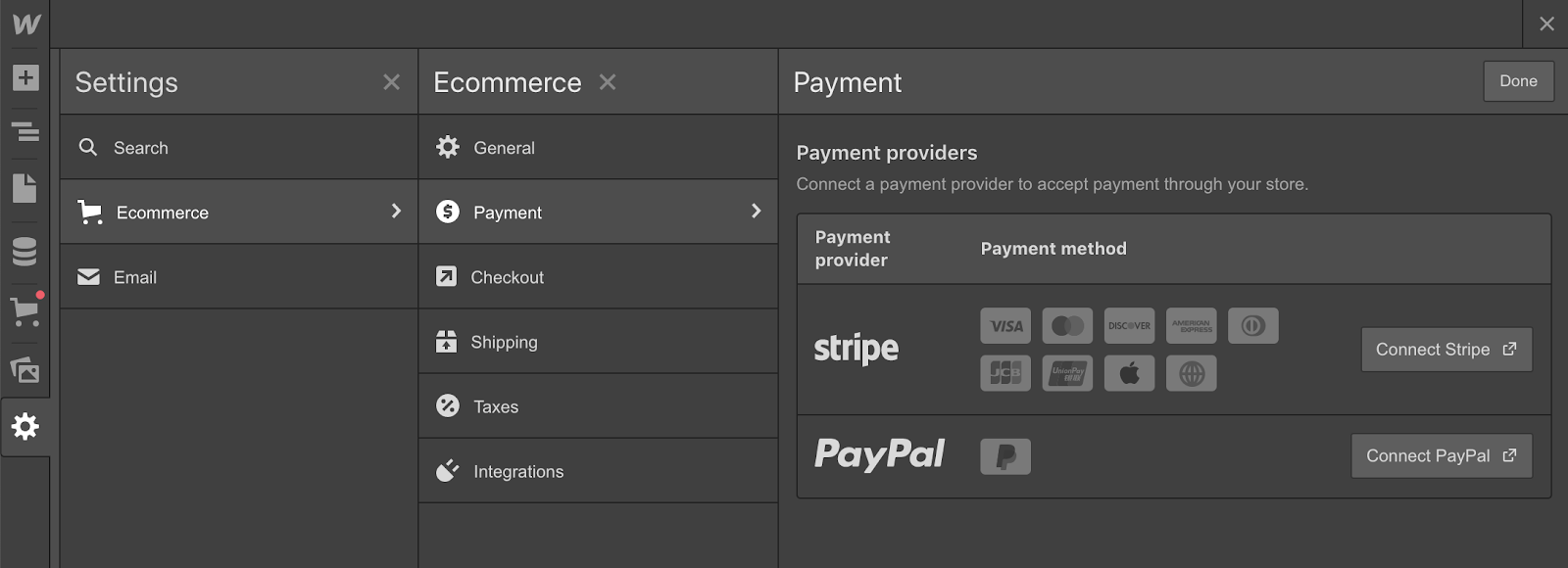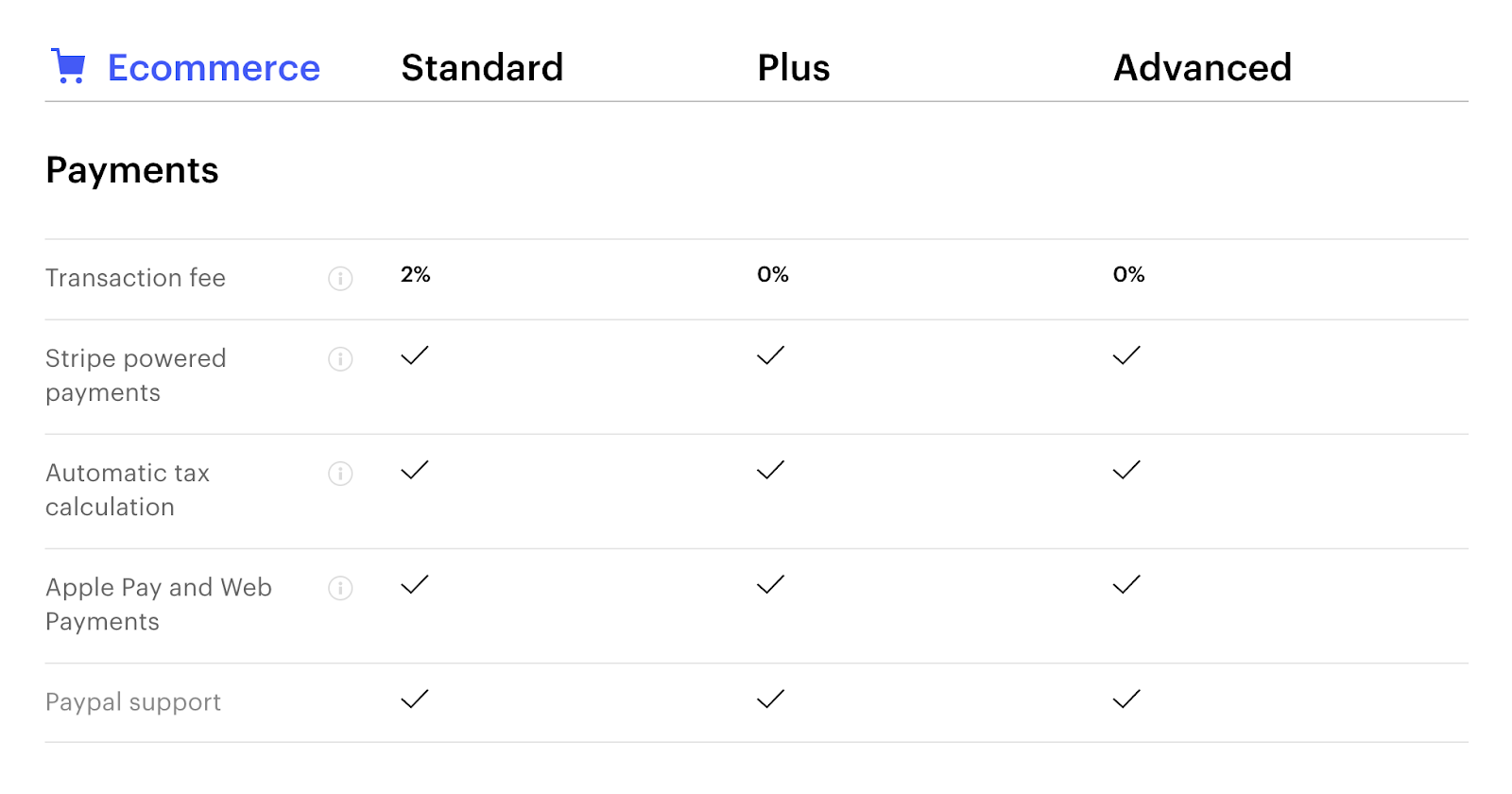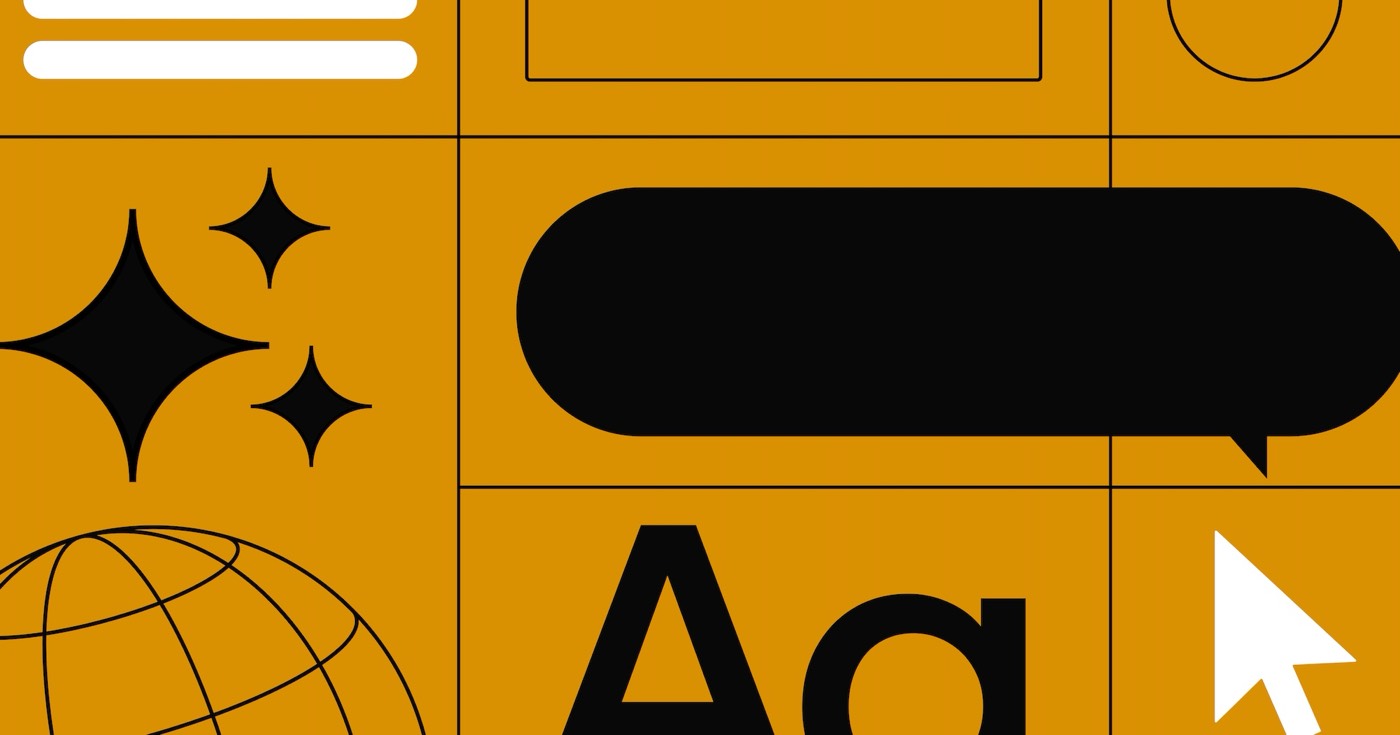Integrate Stripe [↗] or PayPal [↗] as your selected payment service to receive payments on your website. You must establish and link your Stripe or PayPal account to Webflow to gather payments, handle refunds, and receive payouts. This can be accomplished through the Ecommerce payment configurations within the Designer or the Editor.
Included in this tutorial
- Establish connectivity with Stripe or PayPal via the Designer
- Connect with Stripe or PayPal through the Editor
- Common inquiries
Initiate the Connection with Stripe or PayPal via the Designer

Connecting with Stripe or PayPal via the Editor
Entrepreneurs and customers alike can form and join their individual Stripe or PayPal accounts through the Ecommerce settings on the Editor. If not done already, activate the checkout option.

Notes:
- Decorate and insert Stripe Web payments or the PayPal button without linking to a Stripe or PayPal account
- At least one payment method must be enabled prior to activating checkout
Frequently asked queries
Do Stripe and PayPal have global support?
Stripe and PayPal may not operate in all nations. In cases of setting up a store in an unsupported region, Stripe Atlas [↗] facilitates easy establishment of a U.S. enterprise, opening of a U.S. bank account, and initiation of payment acceptance via Stripe, irrespective of your location.
Accounts from the following regions do not offer compatibility for Webflow’s PayPal integration [↗]:
- Turkey
Further Reading:
What are the payment methods accepted by Webflow Ecommerce?
- Acceptance of credit or debit card payments (Visa, Mastercard, American Express, Discover, Diners Club, JCB) via Stripe and PayPal
- Facilitation of Web payments (like Apple Pay and Google Pay) via Stripe
- Availability of PayPal Credit for easy purchase financing, based on customer location and browser
Dive Deeper: Activating Web Payments
References:
- Strategies for accepting credit cards through Stripe [↗]
- Credit card acceptance via PayPal [↗]
- List of currencies supported by Stripe for transactions and disbursements [↗]
- Insights on how Stripe handles currency conversions [↗]
- Explanation of PayPal’s approach to currency conversions [↗]
- Resolving issues related to failed Stripe payments and ways to minimize declines [↗]
- Addressing reasons for unsuccessful PayPal transactions and techniques to reduce decline rates [↗]
Are there charges for credit card processing?
There might be fees imposed by Stripe and PayPal, such as transaction charges and a percentage of the transaction value for each credit or debit card transaction processed. The fee structure varies based on your country or the card used at checkout. These processing fees by Stripe/PayPal are applicable with each successful transaction. Taxes may or may not be included in these fees. For additional details, contact Stripe [↗] or PayPal [↗] for clarification.
Are transaction fees applicable?
A 2% additional transaction fee is imposed on websites subscribed to the Standard site plan — this plan is the smallest in terms of Ecommerce sites. No transaction fee is levied on higher-tier plans.

Is there a restriction on the type of products I can sell using these payment gateways?
By enrolling with Stripe or PayPal, you are affirming your compliance with their guidelines. Explore further on permissible and restricted items for sale through Stripe or PayPal in their documentation.
- Explanation on prohibited businesses and products by Stripe and the reasons behind it [↗]
- Guidelines in PayPal’s Acceptable Use Policy [↗]
How can I receive my payouts?
Stripe and PayPal facilitate transfers (payouts) from your account balance (funds from payments, refunds, etc.) into your bank account.
PayPal transfers:
Proceeds from PayPal checkout get directed to your PayPal account, and then you can move the funds to your bank account. Payouts follow your account’s payout timetable.
Stripe transfers:
Payouts are executed according to your Stripe account’s payout schedule. You can view all your payouts and their expected deposit date into your bank account in the payout section of your Stripe Dashboard.
Additional references:
How are conflicts and deceitful activities managed?
A challenge arises when a payee files a claim with their card-issuing bank to report unauthorized transactions and seeks a chargeback to refund the money to the customer. Unauthorized transactions may result from a fraudulent purchase (stolen card or card details) or a disagreement between the customer and the merchant (pertaining to price, purchased item, etc.).
- Detailed insights on disputes and fraud, along with the process with Stripe [↗]
- Preventive measures for disputes and fraud by Stripe [↗]
- Resolving disputes, claims, and chargebacks via PayPal [↗]
- Tips for avoiding disputes and chargebacks with PayPal [↗]
Webflow Ecommerce adheres to the European Strong Customer Authentication (SCA) [↗] regulations aimed at minimizing fraud. Thus, for online stores in the European Economic Area (EEA) [↗], customers from EEA countries need to undergo an extra layer of authentication to confirm payment for their purchase. By verifying their identity through the procedure initiated by their card-issuing bank, the customer endorses the purchase and reduces the likelihood of unauthorized parties making fraudulent purchases with their card. This dual-factor authentication shifts the responsibility of fraud prevention from the merchant to the payee, hence reducing disputes and chargebacks.
Note: Contested payments also incur a fee. If the customer’s bank resolves the dispute in your favor, this fee is completely reimbursed.
Can refunds be issued?
Refunds can be initiated from the Orders section in the Editor or Designer. No fees are charged for refunding a transaction.
What do the SCA and PSD2 Regulations entail? Am I impacted?
In mid-September 2019, new European regulations for authenticating online transactions came into effect in Europe under the revised Payment Services Directive (PSD2) [↗]. The Strong Customer Authentication (SCA) [↗] standards are applicable to businesses in the European Economic Area (EEA) [↗] that accept online card payments from cardholders whose banks are also situated in the EEA.
As a Webflow merchant in the EEA, what actions should I take to ensure my store is compliant with SCA?
Webflow incorporates Stripe checkout, which fully supports SCA 3D Secure authentication during checkout, prompting customers to provide additional verification only when deemed essential. Gain further insights.
For merchants in the European Economic Area (EEA) [↗], to ensure PSD2 and SCA compliance in your Webflow Ecommerce store for European patrons, re-publish your store if it was not last published on or after September 11, 2019.
Addressing Stripe/PayPal glitches
While troubleshooting PayPal issues, ensure that:
- Your PayPal account is categorized as a Business PayPal account.
- The default currency in your Webflow Ecommerce settings matches the base currency in your PayPal account.
- Your PayPal account email has been validated. (In case you attempted integration before email verification, log in to your PayPal Account Settings, remove Webflow, verify your email with PayPal, and then reinitiate the Webflow integration.)
- Your PayPal account is linked to only one Webflow Ecommerce project. (For multiple Ecommerce platforms, individual PayPal accounts are required for each.)
- Previously connected PayPal accounts should be delinked from the previous Webflow project and permissions should be revoked from PayPal’s end as well as.
If you encounter persistent difficulties in connecting to Stripe/PayPal from the Webflow Ecommerce settings panel or face challenges in refunding orders, please reach out to Webflow support.
For assistance with queries concerning Stripe/PayPal, like bank transfers, refunds, declined charges, etc., you can contact Stripe [↗] or PayPal [↗].
- Include or eliminate Workspace spots and members - April 15, 2024
- Centering box summary - April 15, 2024
- Store a site for future reference - April 15, 2024

